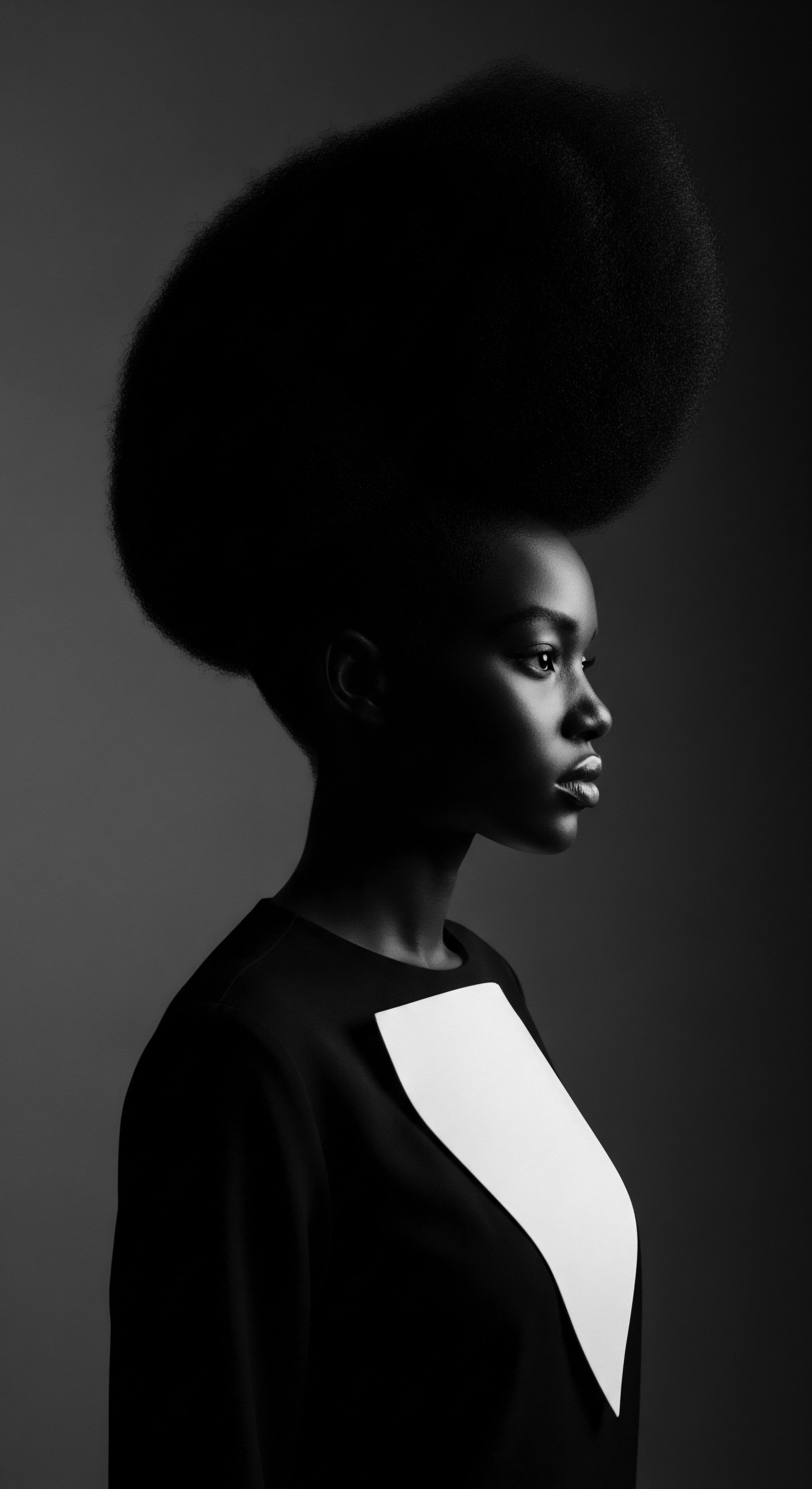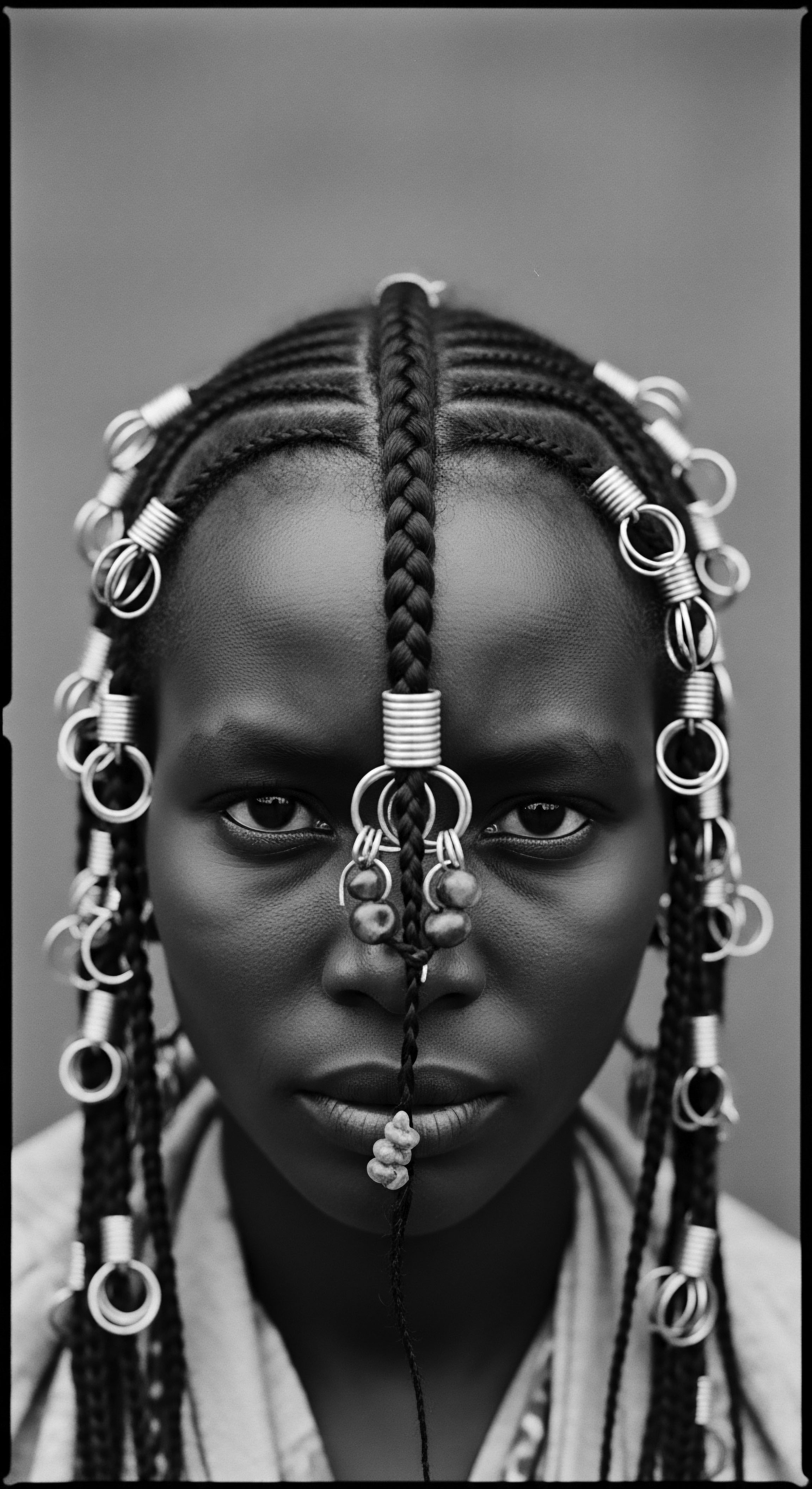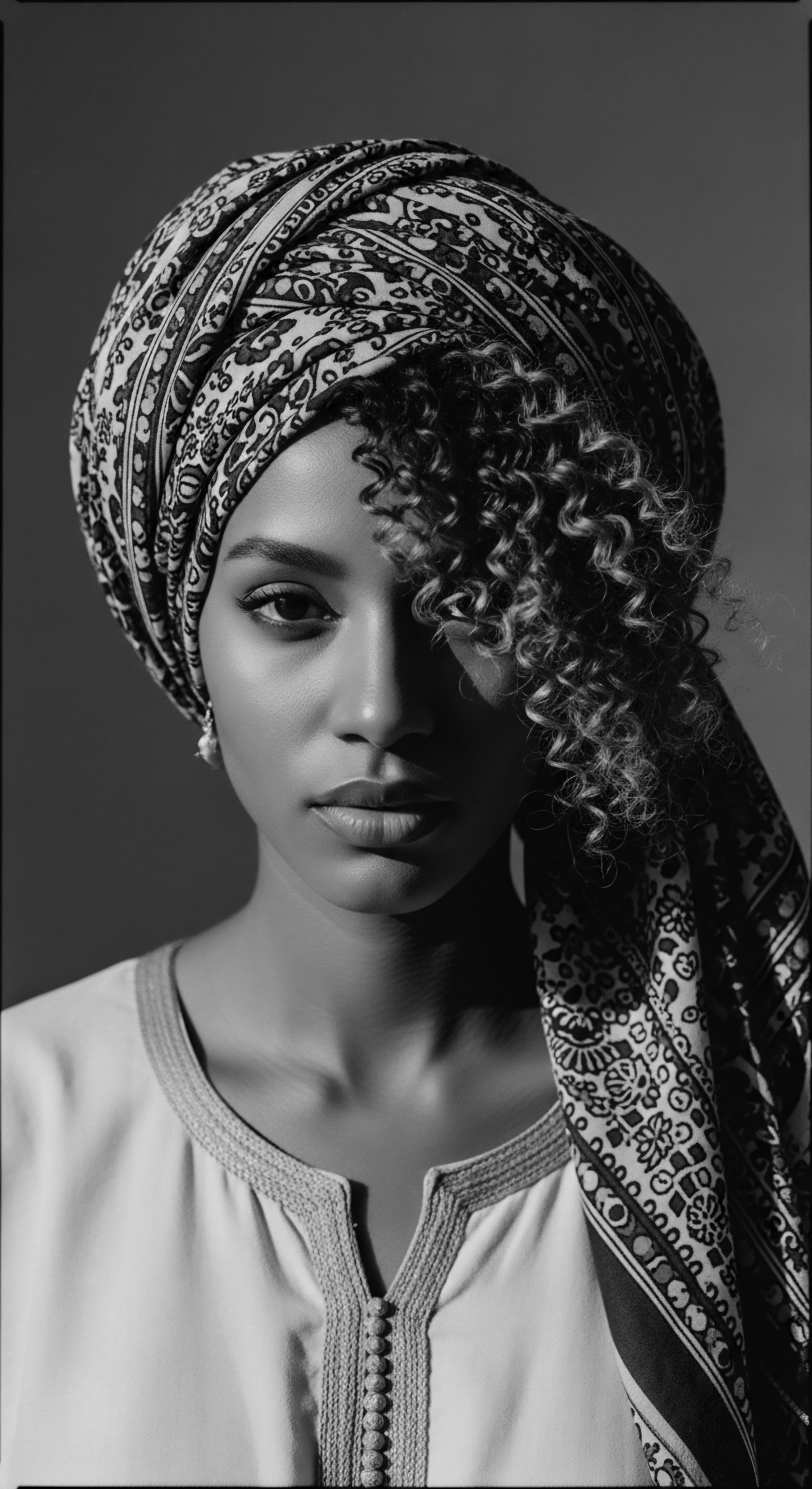
Roots
To stand on the threshold of understanding what hair coverings signify in Black heritage is to step into a lineage, a vibrant, living archive where every strand tells a story. This journey commences not with a gentle whisper, but with the resounding echo of a drum, a rhythm carried through time in the very helix of textured hair. Consider for a moment the profound connection between the earth and the crowns of our ancestors, a bond stretching back to the earliest African civilizations. Here, hair was not simply a physical attribute; it served as a living map of identity, a canvas for spiritual expression, and a conduit for community.
It was a language spoken through plaits, coils, and intricate styles, each conveying a person’s age, marital status, tribal affiliation, or social standing. The very nature of textured hair, with its remarkable density and coiling patterns, lent itself to elaborate styling, capable of holding forms that communicated a wealth of information at a glance.
From this foundational understanding springs the practical necessity and cultural power of hair coverings. The African sun, a powerful force, demanded protection. Dust, daily life, and the need for hygiene also played their part. Yet, these coverings were never merely utilitarian.
They were extensions of the self, expressions of artistry, and sometimes, a deliberate shield against the elements or unwelcome gazes. They served as a second skin for the hair, preserving carefully crafted styles and protecting delicate strands. This primal understanding of hair’s vulnerability and its profound connection to identity established the bedrock for practices that would traverse oceans and centuries, adapting yet retaining their core meaning.

Ancestral Crowns and Earth’s Whisper
In many ancient African societies, hair was a direct link to the divine, the ancestors, and the cosmos. The crown of the head was considered a sacred portal, a place of spiritual reception and connection. To adorn or cover the head was an act of reverence, a acknowledgment of this sacred space. This belief system manifested in elaborate hairstyles and the ceremonial use of head coverings, often crafted from locally sourced materials and imbued with symbolic meaning.
For instance, in some West African traditions, the artistry of hair braiding was a respected skill, often passed down through generations, with specific patterns reserved for royalty or spiritual leaders. The coverings used would then complement these intricate styles, adding layers of meaning and protection.
The very texture of African hair, characterized by its varying degrees of curl, coil, and zig-zag patterns, profoundly shaped these ancestral practices. This hair, unlike straighter textures, naturally holds styles and can be molded into sculptural forms, making it ideal for the elaborate designs seen in ancient carvings and historical accounts. This inherent quality of textured hair made hair coverings a logical extension of its care and adornment, rather than an imposition.
They were not designed to hide what was considered “unruly,” but rather to preserve and celebrate what was already revered. The practice of covering the hair, therefore, grew organically from the unique attributes of textured hair and the spiritual philosophies that surrounded it.
Hair coverings in Black heritage began as protective measures and symbols of identity, rooted in the spiritual reverence for textured hair in ancient African societies.

The Elemental Science of Protection
Understanding the anatomy and physiology of textured hair provides scientific validation for ancient practices surrounding hair coverings. The helical structure of coily and kinky hair types makes them susceptible to moisture loss and mechanical damage. Each bend and curve along the hair shaft represents a potential point of weakness where the cuticle can lift, leading to dryness and breakage. This is where hair coverings, particularly those crafted from smooth materials, traditionally came into play.
- Moisture Retention ❉ Smooth fabrics like silk, often historically used in African and diasporic contexts for head wraps, minimize friction, preventing the absorption of natural oils and moisture from the hair. This is crucial for textured hair, which tends to be drier than other hair types due to its structural properties.
- Physical Shield ❉ A covering acts as a barrier against environmental stressors ❉ sun exposure, wind, dust, and even the abrasive surfaces of daily life. In sun-drenched climates, a headwrap provided essential protection against UV radiation, which can degrade hair protein and further compromise its health.
- Style Preservation ❉ Complex braided or coily styles, often taking hours to create, could be preserved for longer periods with the aid of a covering. This reduced the need for frequent manipulation, which, in turn, minimized breakage and encouraged length retention.
This interplay between the hair’s intrinsic biology and the ingenuity of ancestral practices highlights a deep, inherited wisdom regarding textured hair care. The science of today merely offers a lexicon for phenomena understood through observation and tradition for countless generations.
| Traditional Application Protecting hair from harsh sun and dust |
| Scientific Rationale Shields against UV damage, prevents environmental debris accumulation |
| Traditional Application Preserving intricate hairstyles |
| Scientific Rationale Reduces mechanical friction, minimizes style disruption, aids length retention |
| Traditional Application Signaling social status or identity |
| Scientific Rationale Visual communication, cultural marker, community belonging |
| Traditional Application The enduring legacy of hair coverings speaks to an inherited understanding of textured hair's specific needs. |

Ritual
The passage of centuries witnessed hair coverings evolve beyond elemental protection, weaving themselves into the very fabric of daily ritual and communal life within Black heritage. The rhythms of care, the gathering of families, and the solemnity of ceremony all found expression through the varied forms of headwraps, scarves, and bonnets. These were not static garments; they were alive with meaning, continually shaped by the hands that tied them and the histories they bore. As communities shifted and adapted, so too did the significance of these coverings, becoming silent yet potent declarations of identity and belonging.
Consider the daily dawn, a gentle unfolding of a new day. For countless Black women across generations, this beginning included a ritual of hair care, often culminating in the careful placement of a head covering. This practice was a whisper of self-care, a quiet moment before the world descended, a personal act of tending to one’s crown.
The transition from private care to public presentation often involved a specific style of wrap, each fold and knot carrying a quiet narrative. This inherent connection to daily routines solidified hair coverings as a cherished part of life, a practice passed down through observation and gentle guidance within families, echoing ancestral wisdom.

How Do Headwraps Embody Resistance and Cultural Continuity?
The tragic rupture of forced migration, the transatlantic slave trade, brought with it a brutal attempt to strip Africans of their identity and heritage. Hair, a powerful symbol of status, spirituality, and tribal affiliation in pre-colonial Africa, became a target. Enslavers often shaved the heads of captured Africans, a dehumanizing act designed to erase connection to homeland and lineage.
Yet, even in the crucible of enslavement, the spirit of self-preservation and cultural memory found ways to endure. Head coverings, though sometimes forced upon enslaved women as a mark of servitude, were subtly reclaimed and imbued with new meanings.
These coverings became a silent language of defiance, a visual testament to an unyielding spirit. Intricate wrapping styles, specific colors, or the very act of wearing a wrap could convey messages among enslaved communities, allowing for communication beyond the earshot of overseers. This transformation from a symbol of oppression to an emblem of covert resistance speaks volumes about the resilience of Black women and their profound connection to hair as a cultural marker. After the formal abolition of slavery, the headwrap continued to serve as a symbol of identity and a link to African heritage, even as societal pressures sometimes sought to diminish its value.
The historical example of the Tignon Laws in late 18th-century Spanish colonial Louisiana vividly illustrates this dynamic. Governor Esteban Rodríguez Miró enacted these laws in 1786, mandating that free women of color cover their hair with a tignon or handkerchief in public. The intent was to visually differentiate them from white women, curtail their perceived social and economic threat, and ostensibly halt “plaçage unions” between white men and free women of color whose elaborate hairstyles were drawing considerable attention.
The Tignon Laws, intended to diminish and control, were met with an ingenious transformation by Black women who made the mandated head coverings into opulent statements of defiance and identity.
Far from achieving their intended effect, the Creole women of color responded with audacious creativity. They transformed the simple tignon into statements of unparalleled elegance, using luxurious fabrics, vibrant colors, and intricate tying methods. These elaborate headwraps, adorned with jewels, feathers, and ribbons, became symbols of their beauty, resourcefulness, and unbroken spirit. This historical moment serves as a powerful case study, demonstrating how an instrument of oppression was subverted into a powerful expression of identity and resistance, forever linking hair coverings to the heritage of Black women’s ingenuity.
Virginia M. Gould, a historian, has noted that Miró’s laws aimed to control women who “competed too freely with white women for status and thus threatened the social order”. This resistance through sartorial choices remains a cornerstone of textured hair heritage.

Traditional Styling Influences and Their Protectors
Hair coverings are inextricably tied to the history of Black hair styling, particularly protective styles. Styles such as braids, twists, and locs, which have roots dating back thousands of years in Africa, were not only aesthetic expressions but also practical methods for maintaining hair health. These styles, often intricate and time-consuming to create, benefited immensely from the protection offered by head coverings.
- Gele (Nigeria) ❉ An elaborate headwrap, often made from stiff, luxurious fabrics, worn by Yoruba and Igbo women for celebrations and special occasions. Its complexity often signaled social standing.
- Duku (Ghana/Malawi) ❉ A more general term for headwraps, reflecting everyday use and cultural significance in various West and Southern African countries.
- Doek (South Africa/Namibia) ❉ Another regional term, often worn as a sign of humility or respect, particularly by married or elder women.
The evolution of these styling practices, from ancient traditions to contemporary expressions, has always acknowledged the vital role of hair coverings. Whether for maintaining the integrity of a fresh set of braids, protecting locs from the elements, or simply preserving a defined twist-out overnight, the covering serves as a silent partner in the journey of textured hair. This deep connection between styling, protection, and head coverings illustrates a comprehensive approach to hair care rooted in ancestral practices. The bonnet, in particular, a simpler form of head covering often made from satin or silk, emerged as a universal accessory, guarding against friction and moisture loss during sleep, thus extending the life of styles and promoting hair health.

Relay
The journey of hair coverings in Black heritage is a complex relay, a handing down of meaning and resilience through generations, each era adding its unique impress while retaining the core message. It is a story told not only in the rustle of fabric but in the very structures of society, in laws, and in the enduring spirit of defiance. This exploration moves beyond personal practice to examine the profound socio-political implications and cultural affirmations embodied in head coverings, drawing from scholarly insights and historical records.
The imposition of hair coverings during slavery, a stark contrast to their pre-colonial celebratory usage, transformed them into a visible marker of subjugation. Enslaved African women were often mandated to cover their hair, a punitive measure designed to strip them of cultural identity and beauty. This act was a deliberate attempt to erase the rich tapestry of ancestral hair practices, which held immense spiritual and social weight.
Yet, the very act of covering, initially a tool of oppression, became a clandestine space for resistance and cultural preservation. This historical paradox shapes the contemporary understanding of hair coverings as symbols of both struggle and triumph.

When Did Hair Coverings Become Symbols of Liberation?
The reclamation of the headwrap as a symbol of freedom and cultural pride represents a powerful narrative within Black heritage. Following the oppressive period of slavery, the significance of hair coverings underwent a profound transformation. While their utility for hair care remained, their public display shifted, sometimes falling out of favor in attempts to conform to Eurocentric beauty standards. However, the rise of Black pride movements, particularly in the mid-20th century, saw a resurgence in the conscious embrace of natural hair and traditional African attire, including headwraps.
The 1960s and 1970s marked a pivotal era where the afro became a powerful symbol of political and cultural resistance. Simultaneously, the headwrap re-emerged as a potent emblem, worn boldly as a declaration of African identity and a rejection of imposed beauty norms. This period witnessed hair coverings become interwoven with broader civil rights struggles, representing a visible connection to ancestral roots and a refusal to be culturally assimilated.
The headwrap became a uniform of rebellion, signifying absolute resistance to the loss of self-definition (Stancil, cited in Art, Design, and Visual Thinking,). This intentional shift demonstrates a communal and individual agency in redefining meaning and reclaiming power.
- Black Power Movement ❉ Headwraps served as a visual affirmation of Black identity and a rejection of Eurocentric beauty standards.
- Pan-Africanism ❉ They symbolized unity and connection to the African continent across the diaspora.
- Feminist Movements ❉ For Black women, headwraps became a statement of self-possession and autonomy over their bodies and appearance.

How Do Hair Coverings Bridge Ancestral Practice and Modern Wellness?
The intersection of ancient wisdom and modern scientific understanding is particularly apparent in the continued relevance of hair coverings for textured hair wellness. The very qualities that made headwraps practical in ancient times — protection from elements, moisture retention, and style preservation — remain paramount today. Contemporary research into the unique structure of textured hair validates the efficacy of these time-honored practices.
A significant aspect of modern textured hair care revolves around minimizing friction and retaining hydration. Bonnets, often made from satin or silk, serve this purpose during sleep, creating a smooth surface that prevents the hair cuticle from snagging and lifting, thereby reducing breakage and maintaining moisture levels. This contemporary practice, though perhaps simpler in form than an elaborate gele, shares a direct lineage with ancestral methods of protecting and preserving hair integrity. The choice of materials, from traditionally cultivated fibers to modern innovations, always centers on supporting the hair’s inherent needs.
| Historical Era Pre-Colonial Africa |
| Primary Significance of Hair Coverings Cultural identity, spiritual reverence, social status, protection from elements |
| Historical Era Slavery and Colonialism |
| Primary Significance of Hair Coverings Forced subjugation, covert resistance, cultural continuity |
| Historical Era Post-Slavery & Civil Rights Era |
| Primary Significance of Hair Coverings Resistance, cultural pride, political statement, self-expression |
| Historical Era Contemporary Period |
| Primary Significance of Hair Coverings Hair protection, fashion, cultural affirmation, personal style |
| Historical Era Each epoch adds a layer of meaning to the enduring story of hair coverings in Black heritage. |
Furthermore, the use of hair coverings in specific rituals, from religious ceremonies to personal meditative practices, underscores their enduring spiritual and psychological importance. Many Black women utilize bonnets or headwraps not just for physical protection but as part of a holistic wellness regimen, fostering a sense of grounding and self-care that echoes ancestral reverence for the sacredness of the head and hair. The practice offers a quiet moment of connection, a subtle nod to the wisdom passed down through time.

Reflection
The journey through the historical significance of hair coverings in Black heritage unfolds as a testament to profound resilience and ingenious adaptation. From the ancient African plains where textured hair was revered as a connection to the divine and a map of identity, to the brutal realities of transatlantic slavery where coverings became instruments of both oppression and clandestine defiance, and onward to their powerful re-emergence as symbols of pride and liberation in modern movements, the story is continuously written. It is a living, breathing archive within each coil and strand, a testament to an unbroken lineage of wisdom and strength.
The simple act of placing a covering upon one’s hair, whether a vibrant headwrap for a celebration or a silken bonnet for the quiet of night, extends beyond mere fashion or utility. It is an affirmation of a heritage that refused to be extinguished, a dialogue across generations, and a whisper of ancestral wisdom. It is a connection to the ingenuity of foremothers who transformed forced coverings into opulent statements, echoing a creative spirit that could not be contained.
The legacy of textured hair, with its unique needs and inherent beauty, finds a powerful guardian in these coverings, allowing it to thrive, to defy, and to continue telling its luminous story. This enduring presence of hair coverings stands as a powerful symbol of identity, a visual lexicon for an unbreakable people, forever shaping the heritage of Black hair.

References
- Byrd, Ayana D. and Lori L. Tharps. Hair Story ❉ Untangling the Roots of Black Hair in America. St. Martin’s Publishing, 2014.
- Chico, Beverly. Hats and Headwear Around the World ❉ A Cultural Encyclopedia. ABC-CLIO, 2013.
- Gould, Virginia M. The Devil’s Lane ❉ Sex and Race in the Early South. Oxford University Press, 1996.
- Rooks, Noliwe M. Hair Raising ❉ Beauty, Culture, and African American Women. Rutgers University Press, 1996.
- Sherrow, Victoria. Encyclopedia of Hair ❉ A Cultural History. Greenwood Publishing Group, 2006.
